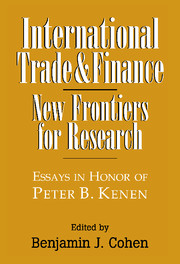Book contents
- Frontmatter
- Contents
- List of contributors
- Introduction
- 1 The practical theorist: Peter Kenen's contribution to international economics
- I International trade theory
- II International monetary theory
- 5 Exchange rate regimes and international trade
- 6 Exchange rates and investment response in Latin America
- 7 Optimum currency areas and exchange rate volatility: Theory and evidence compared
- 8 Optimum currency area theory: Bringing the market back in
- III Applied policy analysis
- Index
8 - Optimum currency area theory: Bringing the market back in
Published online by Cambridge University Press: 11 September 2009
- Frontmatter
- Contents
- List of contributors
- Introduction
- 1 The practical theorist: Peter Kenen's contribution to international economics
- I International trade theory
- II International monetary theory
- 5 Exchange rate regimes and international trade
- 6 Exchange rates and investment response in Latin America
- 7 Optimum currency areas and exchange rate volatility: Theory and evidence compared
- 8 Optimum currency area theory: Bringing the market back in
- III Applied policy analysis
- Index
Summary
Dating back to the pioneering work of Peter Kenen (1969) and others, following Robert Mundell's seminal 1961 article (Mundell 1961), the theory of optimum currency areas (OCAs) has lately enjoyed something of a revival as a result of developments in Europe and elsewhere (Masson and Taylor 1993; Tavlas 1993, 1994). The purpose of this essay, in honoring Kenen, is to contribute to the continuing evolution of this important area of inquiry.
In its first incarnation, OCA theory was strikingly apolitical. Following Mundell's lead, most early contributors, including Peter Kenen, concentrated on a search for the most appropriate domain of a currency irrespective of existing national frontiers. The globe, in effect, was treated as a tabula rasa. The central issue was to find the right criterion for the organization of monetary space. But as the practical limitations of the so-called criterion approach (Tavlas 1994: 213) became clear, an alternative – and, in political terms, seemingly less naive – approach eventually prevailed, focusing instead on costs and benefits of state participation in a common currency area or its equivalent, a regime of irrevocably fixed exchange rates. No longer an irrelevance, the existence of sovereign nations now became the starting point for analysis. Reminding us that countries are not all alike – and thus that no single currency choice is likely to be suitable for all – OCA theory was deliberately reincarnated in a presumably more policy-relevant form.
- Type
- Chapter
- Information
- International Trade and FinanceNew Frontiers for Research, pp. 216 - 244Publisher: Cambridge University PressPrint publication year: 1997
- 2
- Cited by



